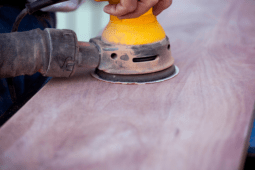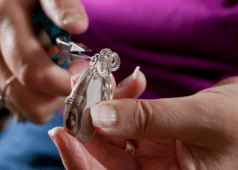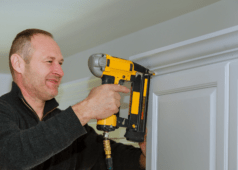How To: Make an Industrial Chic Lamp from Pipe Fittings

Over the last few months, I’ve seen several sets of super cool lights created from plumbing parts at always reliable sites like Design Milk and Boing Boing. In the midst of redoing my own office, I realized I needed a desk lamp to shed a little extra light on smaller tasks. I went to the office supply and home furnishing stores, but I couldn’t find anything that’d work. So, I recalled the pipe fitting lamp I’d seen, and decided to make my own.
Materials
- Assorted pipe fittings from the plumbing aisle. We used the following 1/2″ parts:
- (1x) 6″ nipple
- (1x) 3 1/2″ nipple
- (6x) 1/2″ or “close” nipple
- (5x) 90-degree elbow
- (3x) t-joints
- (1x) 3/4″ – 1/2″ 90-degree reducer
- citrus-based sticker remover
- Lamp cord set with candleabra base socket and rotary switch
- Electric drill with 5/16″ bit
- Hot glue gun
- Cutting pliers
- Electric tape
- Soldering iron (optional)

1. Begin by removing all the stickers and tape from the pipe parts and cleaning them with mineral spirits or citrus-based cleaner.

2. We’ll need to thread the lamp cord through the pipe fixture, and so it’s necessary to cut the cord away from the plug and switch. Use the pliers to cut the cord right above the switch, and then cut the switch out all together. We’ll reinstall it later.

3. Insert a bulb in the socket and thread the now-cut cord through. Place the bulb where it looks best and then use the hot glue to fill the cavity in the reducer to hold the socket in place. Be sure not to get any glue on the threads.

4. Choose a place where the cord will exit the lamp, and drill a 5/16″ hole. When drilling into metal, be sure to use a slow speed and wear proper safety gear. I drilled my hole in the bottom of a t-joint, accounting for the angle at which I knew it would sit.

5. Then, just assemble all the pipe parts as desired, threading the cord through where necessary.

6. Open the rotary switch, and note how the fixture works. Remove the cut cord, then recreate the setup to connect the two ends of the cord. Connect the cold wire (the one with ridges) with solder or by twisting the wires and sealing with electric tape. Insert the hot wire into the proper channels, and close the switch to insert the little teeth. Here’s a helpful how-to for safely working with a switch like these.
7. Test to make sure everything is set up properly, and get to work!










